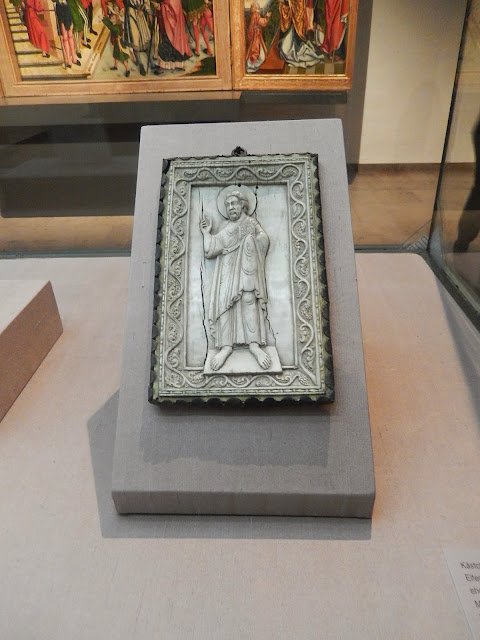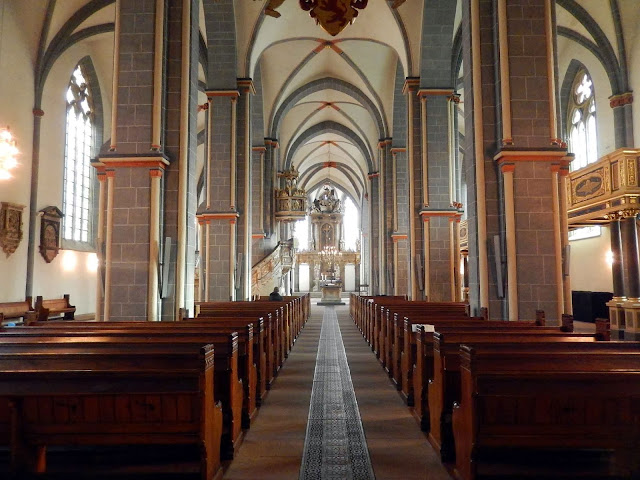Dear Friends
let me say that it was a good idea the proposal of our Gianni to visit together, last Saturday, the exhibition Mineralientage 2013 here in Munich. This year the theme of the exhibition was Gold, the king of metals. Apart from some Gold pieces of circumstance, our attention was attracted by spectacular fossils of small feathered dinosaurs, excellently prepared, showing unusual details of their delicate body structure. Please, have a look to the images and, in case of interest, tell me your opinion.
Salutations
Giancarlo
Mittwoch, 30. Oktober 2013
Freitag, 25. Oktober 2013
Burg Dankwarderode - Braunschweig
Dear Friends
not far from the Sankt Martini church, is located the Dankwarderode Castle which hosts the art collections of the Herzog Anton Ulrich Museum:
http://www.3landesmuseen.de/Herzog-Anton-Ulrich-Museum.304.0.html
and the temporary exhibition: Caesaren, Helden und Heiligen - der römische Soldat in neuzeitlichen Darstellung:
http://www.3landesmuseen.de/Caesaren-Helden-Heilige.1052.0.html .
What I have to sa is that it was for Jean-Luc and me really impossible to recognise the presence of said Roman soldier in the art pieces exposed. In any case, I show you the images collected at the exhibition, so that you too can you try to recognise him.
In any case don't miss to tell me your opinion.
Salutations
Giancarlo
not far from the Sankt Martini church, is located the Dankwarderode Castle which hosts the art collections of the Herzog Anton Ulrich Museum:
http://www.3landesmuseen.de/Herzog-Anton-Ulrich-Museum.304.0.html
and the temporary exhibition: Caesaren, Helden und Heiligen - der römische Soldat in neuzeitlichen Darstellung:
http://www.3landesmuseen.de/Caesaren-Helden-Heilige.1052.0.html .
What I have to sa is that it was for Jean-Luc and me really impossible to recognise the presence of said Roman soldier in the art pieces exposed. In any case, I show you the images collected at the exhibition, so that you too can you try to recognise him.
In any case don't miss to tell me your opinion.
Salutations
Giancarlo
Organs in Braunschweig
Dear Friends
last Sunday took place the announced M.Polo excursion to Braunschweig (DE). Main goal of the excursion was the visit, at the Landesmuseum, of the exhibition: Die Römer Kommen - Roms Vergessener Feldzug, which documents through various artefacts found on the battlefield of Harzhorn the Roman military compaign of Severus Alexander and Maximinus Trax against the Germans -
http://www.3landesmuseen.de/Die-Landesausstellung.996.0.html
http://www.3landesmuseen.de/Braunschweigisches-Landesmuseum.183.0.html .
Unfortunately, take images at the exhibition was strictly forbidden so that I have no image to show you.
However, of particular interest was the visit of the Sankt Martini church which permitted us to discover its magnificent reconstructed Baroque organ:
http://de.wikipedia.org/wiki/St._Martini_(Braunschweig)
and the visit of the Dom in which surprised us its imposant, but rther geometric, main organ: http://de.wikipedia.org/wiki/Braunschweiger_Dom .
The images document said churhes and their organs.
Any comment from your side is welcomed
salutations
Giancarlo
last Sunday took place the announced M.Polo excursion to Braunschweig (DE). Main goal of the excursion was the visit, at the Landesmuseum, of the exhibition: Die Römer Kommen - Roms Vergessener Feldzug, which documents through various artefacts found on the battlefield of Harzhorn the Roman military compaign of Severus Alexander and Maximinus Trax against the Germans -
http://www.3landesmuseen.de/Die-Landesausstellung.996.0.html
http://www.3landesmuseen.de/Braunschweigisches-Landesmuseum.183.0.html .
Unfortunately, take images at the exhibition was strictly forbidden so that I have no image to show you.
However, of particular interest was the visit of the Sankt Martini church which permitted us to discover its magnificent reconstructed Baroque organ:
http://de.wikipedia.org/wiki/St._Martini_(Braunschweig)
and the visit of the Dom in which surprised us its imposant, but rther geometric, main organ: http://de.wikipedia.org/wiki/Braunschweiger_Dom .
The images document said churhes and their organs.
Any comment from your side is welcomed
salutations
Giancarlo
Donnerstag, 17. Oktober 2013
World Press Photo 2013
Dear Friends
it was yesterday, in coming to work, at the Hauptbahnhof here in München, that I visited the exhibition World Press Photo 13. As in the previous editions, the exhibition proposes impressive images on various themes: nature, sport, social events, made by journalists and master photographers. The present edition touch the theme of the war in Syria with particularly crude images which I propose to your attention because they tell you much more about the present syrian reality than millions of words. Any comment from your side is welcomed.
Salutations
Giancarlo
it was yesterday, in coming to work, at the Hauptbahnhof here in München, that I visited the exhibition World Press Photo 13. As in the previous editions, the exhibition proposes impressive images on various themes: nature, sport, social events, made by journalists and master photographers. The present edition touch the theme of the war in Syria with particularly crude images which I propose to your attention because they tell you much more about the present syrian reality than millions of words. Any comment from your side is welcomed.
Salutations
Giancarlo
Freitag, 11. Oktober 2013
Fortress Verona
Dear Friends
one of the thing for which Verona is famous is its important fortifications. Placed in a strategic position for controlling the Adige Valley ( http://it.wikipedia.org/wiki/Valle_dell'Adige ) which permits easier communications between Italy, Austria and Germany, the town were fortified in the ancient times by Romans, Ostrogoths and Longobards, in the middle Age by the Scaligers ( http://en.wikipedia.org/wiki/Scaliger ) and in recent times by Venetians and Austrians. An interesting point, in which it is possible to admire a mix of different times fortifications is on the hills not far from the city. There, joined to the Middle Age wall of Cangrande I Scaliger ( http://en.wikipedia.org/wiki/Cangrande_I_della_Scala ) is the reinforcement provided by an Austrian tower (nr. XXI, 1840), unfortunately not completely accessible. Of interest, in the tower, is a masked security passage which permitted to the Austrian soldiers, in case of war, easy entrance and exit from the city, through the Cangrande's wall. Any comment from your side is welcome.
Salutations
Giancarlo
one of the thing for which Verona is famous is its important fortifications. Placed in a strategic position for controlling the Adige Valley ( http://it.wikipedia.org/wiki/Valle_dell'Adige ) which permits easier communications between Italy, Austria and Germany, the town were fortified in the ancient times by Romans, Ostrogoths and Longobards, in the middle Age by the Scaligers ( http://en.wikipedia.org/wiki/Scaliger ) and in recent times by Venetians and Austrians. An interesting point, in which it is possible to admire a mix of different times fortifications is on the hills not far from the city. There, joined to the Middle Age wall of Cangrande I Scaliger ( http://en.wikipedia.org/wiki/Cangrande_I_della_Scala ) is the reinforcement provided by an Austrian tower (nr. XXI, 1840), unfortunately not completely accessible. Of interest, in the tower, is a masked security passage which permitted to the Austrian soldiers, in case of war, easy entrance and exit from the city, through the Cangrande's wall. Any comment from your side is welcome.
Salutations
Giancarlo
Verona - Iupiter lustralis temple
Dear Friends
last weekend I was in Verona (IT) and after a walking here and there, I decided to go not far from the river Adige, where in a public park I know that there are the ruins of the small Roman temple of Iupiter Lustralis. The ruins originally were located near the ancient Roman gate: Porta Borsari: http://en.wikipedia.org/wiki/Porta_Borsari
but were displaced to the park for facilitating the vehicle circulation. The temple was composed by a bigger hall for the prayers, separated from a smaller hall for the priests by two square columns. After the smaller hall in the sancta sanctorum room was located the statue of Iupiter Lustralis. Unfortunately, nothing remains of the original artefacts and decoration. This temple, I suppose, is similar in architectural style and dimensions to the temple on the Saint Peter hill I described you elsewhere in this blog:
http://m-polo.blogspot.de/2013/05/roman-temple-on-san-pietro-hill-verona.html
Please, have alook to the images and in case of interest, please let me know.
Salutations
Giancarlo
last weekend I was in Verona (IT) and after a walking here and there, I decided to go not far from the river Adige, where in a public park I know that there are the ruins of the small Roman temple of Iupiter Lustralis. The ruins originally were located near the ancient Roman gate: Porta Borsari: http://en.wikipedia.org/wiki/Porta_Borsari
but were displaced to the park for facilitating the vehicle circulation. The temple was composed by a bigger hall for the prayers, separated from a smaller hall for the priests by two square columns. After the smaller hall in the sancta sanctorum room was located the statue of Iupiter Lustralis. Unfortunately, nothing remains of the original artefacts and decoration. This temple, I suppose, is similar in architectural style and dimensions to the temple on the Saint Peter hill I described you elsewhere in this blog:
http://m-polo.blogspot.de/2013/05/roman-temple-on-san-pietro-hill-verona.html
Please, have alook to the images and in case of interest, please let me know.
Salutations
Giancarlo
Abonnieren
Posts (Atom)



















































